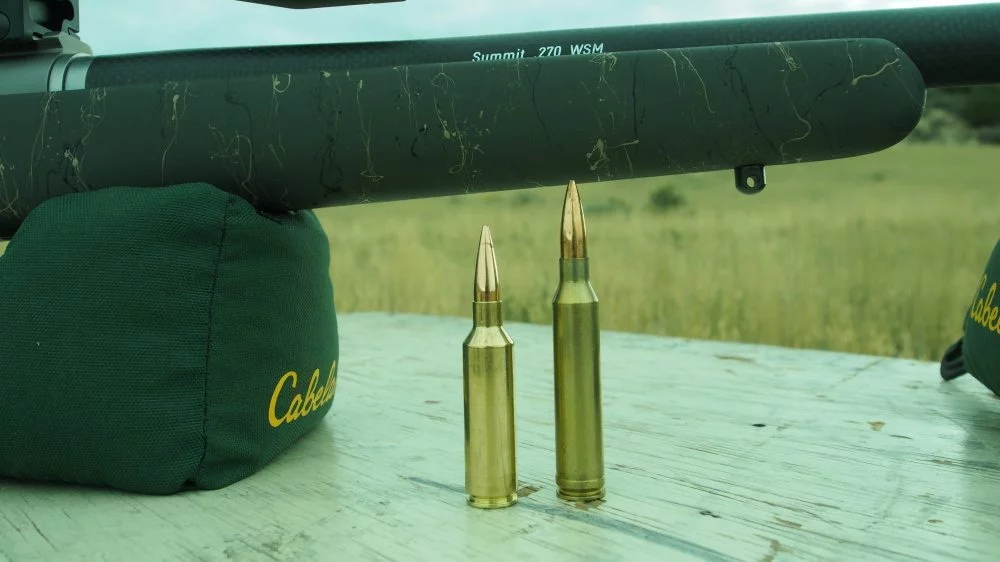
I started out hunting mule deer in the early 1980’s with a 30.06. That caliber served me well until one early morning hunting near Hoback, Wyoming. A 170″ buck appeared at timber’s edge at approximately 600 yards. With no way to get closer, I held several feet above his back and touched her off. Dust flew well below his front hooves and like it is with most big bucks, he disappeared forever.
Within a week, I purchased a 7mm Remington Magnum known for the flattest trajectory in the magnums at the time. I fell in love with the caliber and hunted nearly 25 years with the “Magnificent 7” as many writers have called her. While rangefinders and range-compensating scopes (both turret-style and hash mark) have lessened the need for near-horizontal trajectory, in the real world of hunting for big mule deer, flat trajectory is still very important. Often a hunter has to make split-second decisions without a rangefinder and has little time to prepare for an accurate shot.
Then in 2001, a new caliber was introduced by Winchester that really caught my attention: the 270 Winchester Short Magnum. While many calibers introduced seem to only split hairs at best with current offerings, the 270 WSM provided a clear advantage over other magnum calibers for the backcountry mule deer (and sheep) hunter: magnum performance in trajectory, and in a lighter faster and stiffer short action. In my book, ounces, seconds, and accuracy rank high when it comes to hunting big mule deer.
To capitalize on the increased powder capacity of the 270 WSM, a 24-26″ barrel is needed, which can negate the weight savings of the short action. Because of this, the mass gun builders produced a lot of rifles chambered in the 270 WSM but these guns only offered a slight weight savings over traditional long action magnums.
I found myself waiting for someone to bring the caliber out in a platform that offered significant weight savings AND an accuracy guarantee of less than an inch. While they are out there now, I needed a company who was also willing to work with Rokslide as a sponsor (I have to pay the bills like everyone else).
Finally, in 2015 Christensen Arms introduced their Summit Carbon Rifle chambered in the 270 WSM (more on that gun in a later post.) This gun in a short action with a 26″ barrel tips the scale at 6 lbs 3 ozs. While you can read all over the internet published velocities of 3200 fps (130 grain bullets) in the 270 WSM, I’ve learned in reality that published velocities are rarely attainable in an accurate load. The extra 2″ on this barrel was just insurance with little weight penalty due to the carbon barrel.
I received my gun in mid-September and was pleased with the range performance of the 270 WSM, as I suspected all these years that I would be. Using a ProChrono (lent to me by Rok Blog subscriber Shane Hayes), I chorongraphed the 130 grain Berger Classic Hunter at and average of 3125 fps over four (3) shot groups with an average group size under 0.75″.
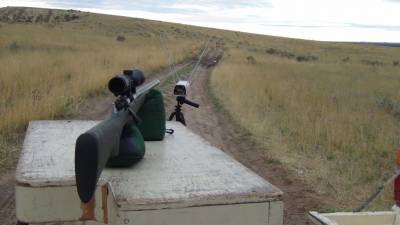
The math works out that this gun will produce a five-inch flatter trajectory over my 7mm Rem. Mag load (168 Berger Classic Hunter) at 500 yards while only giving up 200 ft-lbs of energy (1700 vs. 1900) at the same distance. As I’ll be installing a Vortex scope with their Dead Hold BDC reticle, my last hash mark (I prefer the speed of hash marks over the slower turrets) will take me to at least 600 yards (my practical shooting limit that I discuss in my book “Hunting Big Mule Deer).
The only potential downsides I’ve found in the 270 WSM is the fat case (based on the .404 Jeffery) and a sharp shoulder angle of 35 degrees. In most guns, this can reduce magazine capacity by by one round compared to standard diameter magnum cartridges. Christensen Arms remedies this with an ejectable magazine that extends below the stock. Also, in theory, the sharp shoulder along with a rebated rim might cause feeding problems (not acceptable when hunting big mule deer where mere seconds often count.)
I reached out to several companies in the late 2000s and none could guarantee I wouldn’t experience jamming issues, another reason I waited so long to jump ship to the 270 WSM. Christensen Arms said they’d guarantee the gun for 30 days (standard for everyone) if I experienced feeding problems and I could switch to another caliber. That gave me the confidence to finally make the switch.
Make sure you “Subscribe to blog” (Upper right under Fitness/Other) so you don’t miss my follow-up posts on the field testing of the Vortex Scope, Precision Reflex Inc split Picatinny mounts, and of course the Christensen Arms Summit Carbon. Although I’m not a long-range hunter, if you are, you might be especially interested in this project.
To read Part II, click Goodbye 7mm Rem Mag, Hello 270 WSM Part II
Read all about what’s important to me in a rifle for hunting big mule deer in my new book, Hunting Big Mule Deer




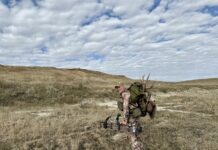

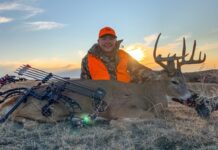

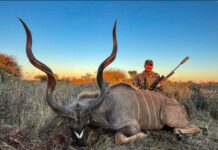





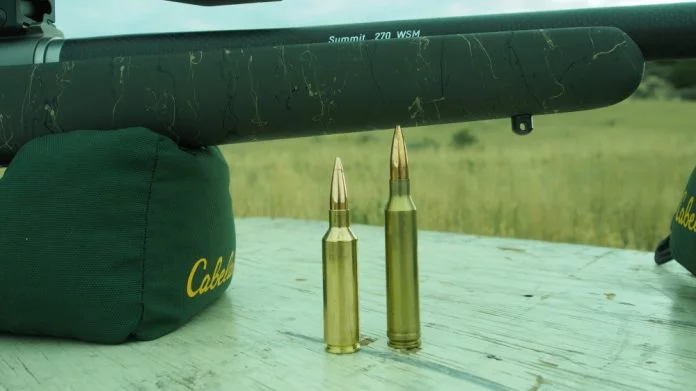
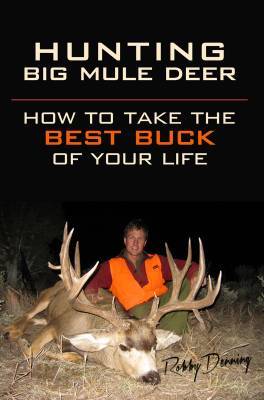
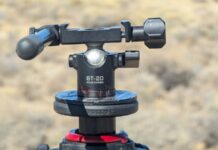
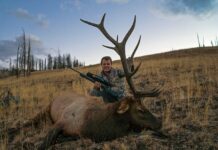



Robby, I used to shoot an old Husqvarna 6.5×55 — beautifully sporterized by my Swedish father-in-law. Peephole sight, never used a scope nor wished for one. Far lighter than the Springfield aught-six I’d been shooting for several years, and reliably accurate. (NOTE: also tried several other similar rifles, e.g. a Japanese 6.5 which I hated.) Several people told me that 6.5×55 Swede was just about the flattest trajectory ever — I don’t know. Quite a few years later my brother in Illinois happened on one at a dusty old gun shop in central Illinois and picked it up for a song. His experiences shooting it mirrored mine back in Oregon.
Ever shot one??
http://bit.ly/1N7hhm6
Kelly, in it’s time, the 6.5×55 was a flat-shooter and certainly a good caliber. Fed reliably even in machine guns. You do leave some energy and trajectory on the table, though. In my follow up article, you’ll see why I still believe the modern magnums are what’s needed for killing big mule deer. Thanks for chiming in…
Robby,
Don’t underestimate the new 26 Nosler. My muley was killed at 530 yards this year and is capable much further.
[img]https://www.tradeexcanada.com/sites/default/files/imagecache/product_full/31457.JPG[/img]
A guy in one of my hunting camps one year spotted a couple of my shells in the kitchen, and asked WTF kind of ammo was THAT. :p Someone else there told him that maybe the closest thing to that calibre was a .270 Roberts — ya think? For many years we couldn’t get new (Norma) ammo and had to re-load; my ex visited Sweden in 1982 and bought a half dozen boxes. Actually got them back through LaGuardia, too.
Nice looking gun Kelly. Thanks for the photo.
Not a gun guy myself. I know the 7 mag is probably flatter than the 270. How does the 7mm wsm compare to the 270 wsm?
Joe it depends on which 7mm bullet you’re comparing. I compared the 130 grain in 270 to 168 in 7mm because that is what I’ve been shooting and what my old Weatherby preferred. On average you’ll need a heavier 7mm bullet which will produce more recoil IN AN ULTRALIGHT rifle like the one I’m putting together for this project. that is why I went with the lighter 270 in 130. It will still have plenty of energy for mule deer and is why thousands of hunters use the 270 Win and 270 WSM.
I shoot a 270 that was handed down from my grandfather to my dad to me. It is about time to hand it down to my nephew as I don’t have children. I am trying to decide what to get in a new rifle and will have to look at the 270wsm.
HEY ROBBIE, I’ve been meaning to ask you about this and keep forgetting … for many years I hunted with either an old Springfield .30-06 or my friendly little old Winchester .30-30 — and an old Montana cowboy friend of mine one day commented that what I really should look into was this:
http://www.kimberamerica.com/news/kimber-raises-700-000-for-nra-foundation
He figured, for me and what/when/how I hunted, that .25-06 was just ideal for me. Ever used one?
(And by the way, did you see Trevor Carlson’s review on your amazon page? Wowsers!)
Thanks for the book. I’ve hunted Blacktail most of my life and have only shot three mule deer (New Mexico, Wyoming, and Oregon). I’m going after the biggest bucks of my life form now on using some of the technique in your book! I’m in Oregon and should draw a good tag next year. I’ll keep you posted.
HEY JIM RAMOS, where in Oregon do you live and where will you hunt in Oregon next year? I guided for years in eastern Oregon, Union and Baker County mostly. Which units are you considering for 2016? Have you hunted over near Rye Valley at all? It’s been years since I hunted E.Oregon (mostly the Starkey unit between La Grande and Pendleton), but if you can get onto private/BLM checkerboard lands in the vicinity of Rye Valley, some of those big ranch areas used to be just crawling with monster mulies. The SE desert lands in the “big” counties can also be good if you know where to go and have a guide or a “friendly intro” to good mule deer habitat …
Kelly,
yes, I’ve seen the Kimbers. Good guns and lots of lightweight options. I have not hunted with one myself. However, the link you post shows that 30.06 at 6lbs 2 ounces. In the follow up post to this one, you’ll see why I chose the 270 WSM in the Christensen Arms- exact same weight with magnum performance in trajectory. Love the ‘ol 30.06 but in the opening line of this post I tell readers why I moved on over 25 years ago. Thanks for the discussion on all this.
Comments are closed.